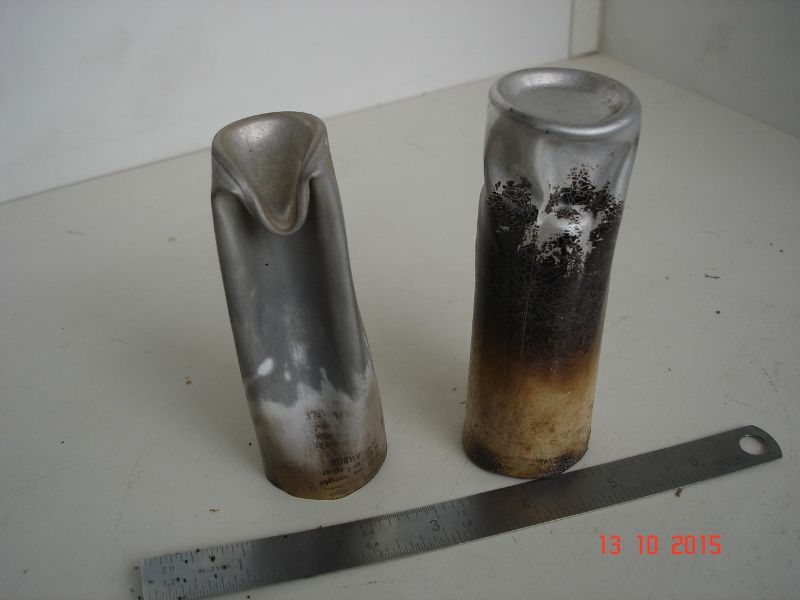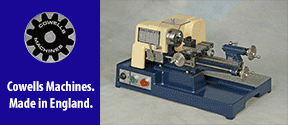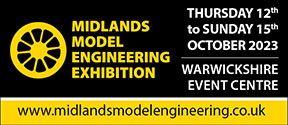Aluminium Firebox
Aluminium Firebox
| Former Member | 14/03/2019 16:46:45 |
| 1329 forum posts | [This posting has been removed] |
| Brian G | 14/03/2019 17:03:03 |
| 912 forum posts 40 photos | Hi Bill He explains why in chapter one of Building Simple Model Steam Engines: "I don't recommend the use of galvanised or zinc-coated steel, as the coating will react with any adjacent copper or brass and cause corrosion. The same applies to aluminium." Brian
|
| Nick Clarke 3 | 14/03/2019 17:08:15 |
1607 forum posts 69 photos | Also the ignition temperature of aluminium in air is given by an internet source as 550C while the hottest part of a methanol flame is given as 1910C Internet sources admittedly, but personal experience does suggest aluminium can burn quite easily. I have seen a bonfire made up of Honda 50 light alloy crankcases - it used to be a 'party piece' at bike rallies.
See http://nuclearpowerradiation.tpub.com/hdbk1081/Table-2-Melting-Boiling-And-Ignition-Temperatures-Of-Pure-Metals-In-Solid-Form-33.htm and http://www.derose.net/steve/resources/engtables/flametemp.html Edited By Nick Clarke 3 on 14/03/2019 17:11:51 |
| Former Member | 14/03/2019 17:14:59 |
| 1329 forum posts | [This posting has been removed] |
| Brian G | 14/03/2019 17:19:53 |
| 912 forum posts 40 photos | Yes Bill, it is in book 1. Brian Edit: Not as bad as some authors, at least both books are still available. My pet hate is "full details are in my earlier (out of print, hard to find and frighteningly expensive) book" (or article in the case of LBSC!). Edited By Brian G on 14/03/2019 17:23:17 |
| SillyOldDuffer | 14/03/2019 17:23:48 |
| 10668 forum posts 2415 photos | Various other problems with Aluminium in addition to Brian's corrosion & compatibility point. Aluminium is hard to solder and weld. Pretty much has to be riveted. Great care would have to be taken to keep it cool because it has a low melting point: Zinc - 420C An ordinary coal fire burns at about 600C, hotter if a blower is used. Under the right conditions, Zinc, Magnesium & Aluminium will burn violently, which can be useful. Thermite is a mixture of rust and aluminium powder and it reaches 2500C - hotter than most gas flames apart from Oxy-acetylene. As the reaction produces a stream of molten iron it's used for welding. Dave
|
| Nigel Graham 2 | 14/03/2019 21:12:22 |
| 3293 forum posts 112 photos | Aluminium / steel, especially stainless-steel, couples are very unhappy partnerships, but it's the steel rather than the aluminium that corrodes. I don't know what happens with aluminium/copper, but I think in some situations it will be the copper that is eaten. This point is also pertinent to anyone building miniature railways with aluminium rail. It may seem best to use stainless-steel fastenings and I know some have done this. However, whilst they are good with mild-steel, the combination risks aluminium-alloy rail-ends corroding rapidly, leaving the stainless-steel screws all smugly bright and shiny. I found this from experience at work, having spent some twenty years trying to tell my far more highly "edumificated" betters why their nice anodised-aluminium test-pieces emerged from a few days in a laboratory tank holding only tap-water containing ordinary swimming-pool treatments, with white "measles", especially around the stainless-steel screws! I am not convinced by the fire risk. The high-Mg proportion aluminium alloys will burn in the right conditions, but the allow we are most likely to encounter is bog-standard HE30 (or whatever it's called now!), which is Al with a trace of copper. That doesn't so readily burn at all. In a simple model steam-boiler it's more likely just to melt if it runs dry.
YET... aluminium alloy IS used commercially for pressure-vessels, and for the heat-exchangers in modern domestic hot-water boilers (though a friend in the trade says they don't last long). If you read the dreaded Pressure Equipment Regulations - the original lawyers' version, more than the DTI guidance-books - you find its authors only ever knew of aluminium or stainless-steel alloys. I think the difference relevant here between commerce and we amateur engineers is that the trade has far greater resources of exotic alloys designed for the intended application classes, their relevant fabrication methods, and sophisticated testing facilities. |
| vintage engineer | 14/03/2019 21:48:12 |
293 forum posts 1 photos | Molten aluminium and water is highly explosive! |
| J Hancock | 15/03/2019 07:43:10 |
| 869 forum posts | Any system made of dis-similar metals and containing an electrolyte ( 'water' It will deconstruct itself fairly quickly without intense care and attention . Think 1960's cars , engine components, bodywork. |
| Hopper | 15/03/2019 07:51:04 |
7881 forum posts 397 photos | Posted by Nick Clarke 3 on 14/03/2019 17:08:15:...
...I have seen a bonfire made up of Honda 50 light alloy crankcases - it used to be a 'party piece' at bike rallies.
Old VW Bug transmission casings worked even better: Magnesium! |
| Former Member | 15/03/2019 07:58:04 |
| 1329 forum posts | [This posting has been removed] |
| Brian G | 15/03/2019 08:21:39 |
| 912 forum posts 40 photos | Posted by Nigel Graham 2 on 14/03/2019 21:12:22:
... This point is also pertinent to anyone building miniature railways with aluminium rail. It may seem best to use stainless-steel fastenings and I know some have done this. However, whilst they are good with mild-steel, the combination risks aluminium-alloy rail-ends corroding rapidly, leaving the stainless-steel screws all smugly bright and shiny....
I once received a phone call from an aeronautical engineer complaining about our supplying him with an aluminium greenhouse equipped with galvanised and stainless steel fittings. I agreed that there should be electrolytic corrosion, but that I had never encountered it in 20 years, and that I had seen 30+ year old buildings without any problems. The only reason I could think of was that the 6063 aluminium formed an oxide skin before this happened. Are there any metallurgists out there that can come up with a better explanation? Brian |
| Tim Rowe | 15/03/2019 10:25:34 |
| 33 forum posts 4 photos | Posted by vintage engineer on 14/03/2019 21:48:12:
Molten aluminium and water is highly explosive! So are all molten metals with very few exceptions including Mercury and specialist low melting point alloys like Cerrosafe. |
| Ian S C | 15/03/2019 11:40:33 |
7468 forum posts 230 photos | It doesn't take too much heat for aluminium to loose it's strength, here's a couple of examples of using aluminium containers for displacers in hot air motors, I'm a slow learner, well actually the second one was put in in a hurry for a demonstration run, and it did demonstrate the reason not to use aluminium after running about half an hour there was a clatter, then stop, the motor now has a stainless steel displacer can. Ian S C |
Please login to post a reply.
Want the latest issue of Model Engineer or Model Engineers' Workshop? Use our magazine locator links to find your nearest stockist!
Sign up to our newsletter and get a free digital issue.
You can unsubscribe at anytime. View our privacy policy at www.mortons.co.uk/privacy
- *Oct 2023: FORUM MIGRATION TIMELINE*
05/10/2023 07:57:11 - Making ER11 collet chuck
05/10/2023 07:56:24 - What did you do today? 2023
05/10/2023 07:25:01 - Orrery
05/10/2023 06:00:41 - Wera hand-tools
05/10/2023 05:47:07 - New member
05/10/2023 04:40:11 - Problems with external pot on at1 vfd
05/10/2023 00:06:32 - Drain plug
04/10/2023 23:36:17 - digi phase converter for 10 machines.....
04/10/2023 23:13:48 - Winter Storage Of Locomotives
04/10/2023 21:02:11 - More Latest Posts...
- View All Topics
- Reeves** - Rebuilt Royal Scot by Martin Evans
by John Broughton
£300.00 - BRITANNIA 5" GAUGE James Perrier
by Jon Seabright 1
£2,500.00 - Drill Grinder - for restoration
by Nigel Graham 2
£0.00 - WARCO WM18 MILLING MACHINE
by Alex Chudley
£1,200.00 - MYFORD SUPER 7 LATHE
by Alex Chudley
£2,000.00 - More "For Sale" Ads...
- D1-3 backplate
by Michael Horley
Price Not Specified - fixed steady for a Colchester bantam mark1 800
by George Jervis
Price Not Specified - lbsc pansy
by JACK SIDEBOTHAM
Price Not Specified - Pratt Burnerd multifit chuck key.
by Tim Riome
Price Not Specified - BANDSAW BLADE WELDER
by HUGH
Price Not Specified - More "Wanted" Ads...
Do you want to contact the Model Engineer and Model Engineers' Workshop team?
You can contact us by phone, mail or email about the magazines including becoming a contributor, submitting reader's letters or making queries about articles. You can also get in touch about this website, advertising or other general issues.
Click THIS LINK for full contact details.
For subscription issues please see THIS LINK.
Model Engineer Magazine
- Percival Marshall
- M.E. History
- LittleLEC
- M.E. Clock
ME Workshop
- An Adcock
- & Shipley
- Horizontal
- Mill
Subscribe Now
- Great savings
- Delivered to your door
Pre-order your copy!
- Delivered to your doorstep!
- Free UK delivery!

 is, essentially ,a battery.
is, essentially ,a battery.









 Register
Register Log-in
Log-in


